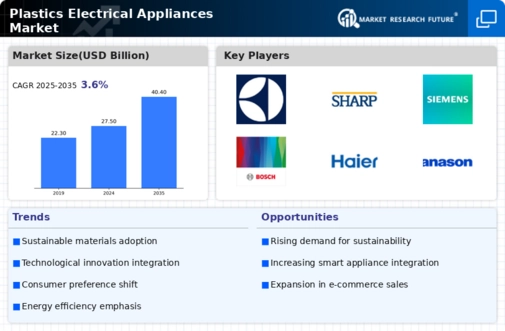Growth of E-commerce Platforms
The rise of e-commerce platforms is transforming the distribution landscape of the Plastics Electrical Appliances Market. Online shopping offers consumers greater convenience and access to a wider range of products, including niche and specialized appliances. This shift is particularly beneficial for smaller manufacturers who can reach a global audience without the need for extensive physical retail presence. Data suggests that e-commerce sales in the appliance sector have seen double-digit growth, indicating a shift in consumer purchasing behavior. As more consumers turn to online channels for their appliance needs, manufacturers are likely to adapt their marketing strategies to capitalize on this trend.
Regulatory Support for Innovation
Regulatory frameworks are playing a crucial role in shaping the Plastics Electrical Appliances Market. Governments worldwide are implementing policies that encourage innovation and the adoption of new technologies in appliance manufacturing. These regulations often focus on energy efficiency, safety standards, and environmental impact, pushing manufacturers to invest in research and development. For example, compliance with stringent energy efficiency standards can lead to the development of advanced appliances that not only meet regulatory requirements but also appeal to environmentally conscious consumers. This regulatory support is likely to foster a competitive environment, driving growth and innovation within the industry.
Rising Demand for Energy Efficiency
The Plastics Electrical Appliances Market is experiencing a notable shift towards energy-efficient products. Consumers are increasingly prioritizing appliances that minimize energy consumption, driven by rising electricity costs and environmental concerns. According to recent data, energy-efficient appliances can reduce energy use by up to 50%, making them attractive to cost-conscious consumers. This trend is further supported by government incentives promoting energy-efficient technologies, which encourage manufacturers to innovate and produce appliances that meet these standards. As a result, the demand for energy-efficient plastics in electrical appliances is likely to grow, influencing design and production processes within the industry.
Technological Advancements in Manufacturing
Technological advancements are reshaping the Plastics Electrical Appliances Market, particularly in manufacturing processes. Innovations such as 3D printing and automation are enhancing production efficiency and reducing costs. For instance, the adoption of advanced polymer materials allows for lighter, more durable appliances that meet consumer demands for performance and longevity. Furthermore, the integration of smart technologies into appliances is becoming commonplace, with manufacturers leveraging IoT capabilities to create connected devices. This evolution not only improves functionality but also aligns with consumer preferences for convenience and efficiency, thereby driving growth in the market.
Increased Consumer Awareness of Sustainability
Consumer awareness regarding sustainability is significantly influencing the Plastics Electrical Appliances Market. As environmental concerns become more prevalent, consumers are actively seeking products that are eco-friendly and made from recyclable materials. This shift is prompting manufacturers to adopt sustainable practices, such as using biodegradable plastics and reducing waste in production. Market data indicates that products marketed as sustainable can command a premium price, reflecting the willingness of consumers to invest in environmentally responsible options. Consequently, this trend is likely to drive innovation and competition among manufacturers striving to meet the evolving expectations of eco-conscious consumers.


















Leave a Comment